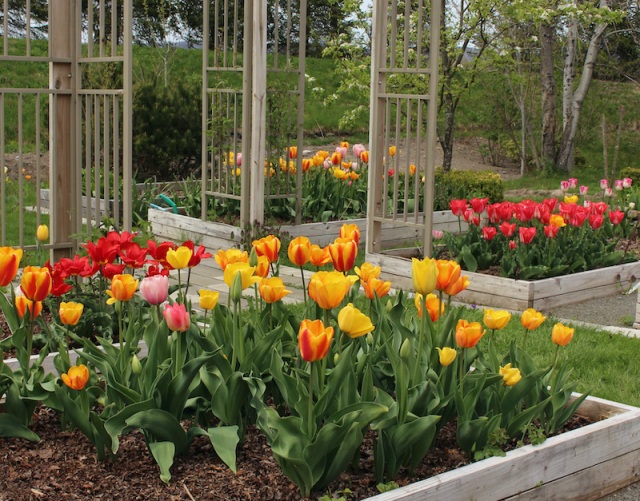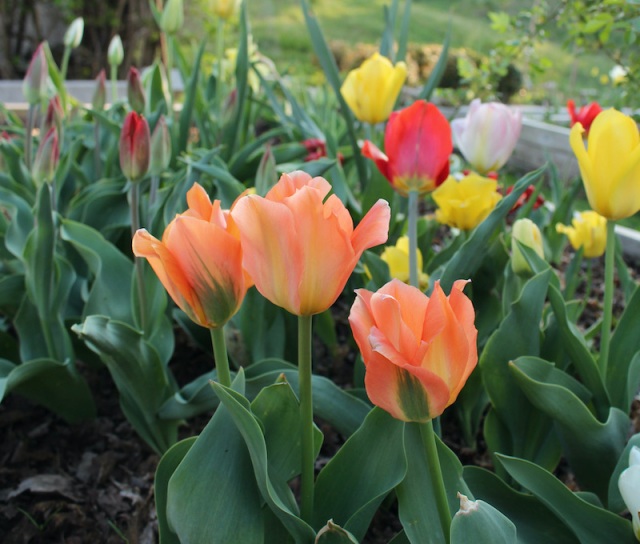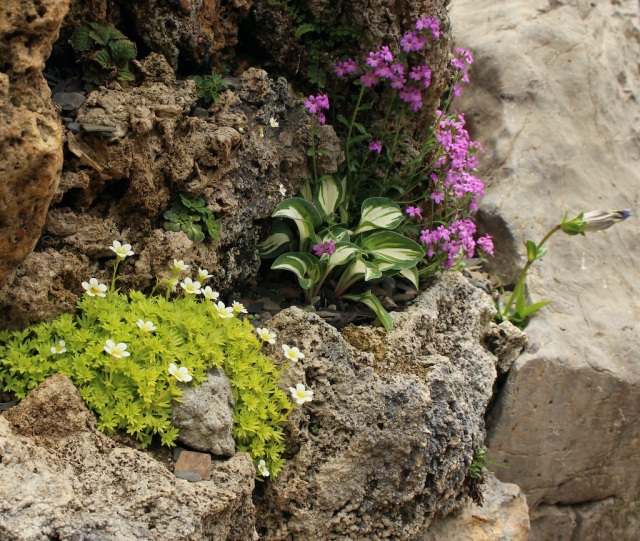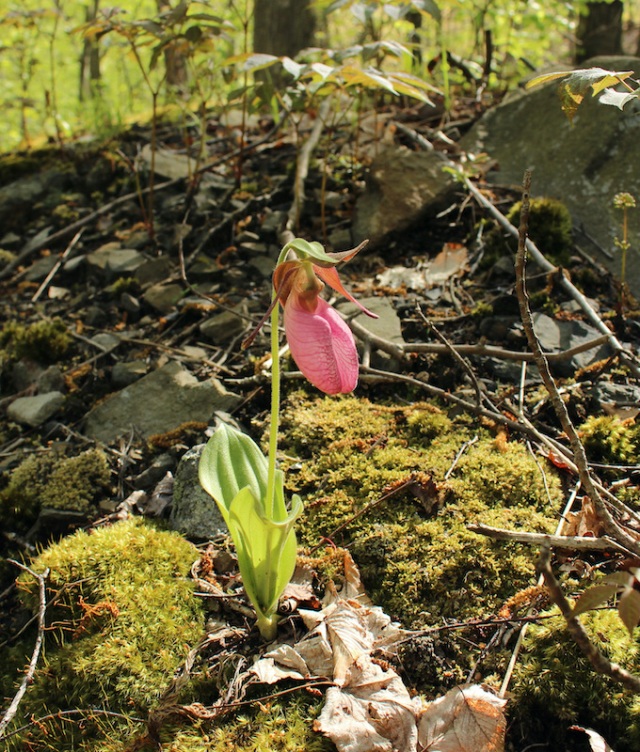The weather has finally warmed up enough here to get things growing, and as usual it’s the tulips and daffodils which are my absolute favorites. They’re not at all subtle and I think that’s needed in order to distract from the raw construction of other parts of the garden.

The border along the street is looking good with a nice show of returning tulips. Some have been in place for over five years and are way overdue for dividing.
Tulips and daffodils are a weakness of mine and it may surprise some that I’ve been on a strict diet for the last two or three years and haven’t allowed myself to buy any new bulbs until I take better care of what’s here. Crowded clumps need dividing in order to show off best and in the case of tulips a string of late freezes and excessively damp springs have brought on some serious plagues of tulip fire botrytis. Fortunately it only takes a few nice flowers in order for me to completely ignore a thousand other issues!

‘Marit’ might be in the top five of favorite tulips. The colors, shape, and size are just amazing to my eye.
This year drier weather has also been helpful in keeping the botrytis down. Between that and some Neem oil spraying last spring things are looking much improved this spring. I’m also ruthlessly ripping out infected shoots and thinning the foliage on still overcrowded clumps. We will see what ‘thinning the foliage’ does to next year’s flowers since obviously the bulbs need the foliage to grow new bulbs, but a few less bulbs might not be the worst thing either.

I’m not sure you can tell that these tulips have been thinned. The one clump of orange was missed, but the others were all dug in late May(?) far earlier than they should have been, and immediately replanted after pulling off and tossing all the smaller bulbs. I’m hoping the show next spring is again solid with color.
I’m pretty sure only the gardener will notice if there are a ‘few less’ bulbs next year. Exponential growth means a hundred tulips can become three hundred in just a year, so better to revel in the luxury of me doing the thinning rather than disease or *gulp* deer or other vermin doing it for me. Thank goodness the deer still avoid my garden.

An overcrowded daffodil patch. Sadly this is a newer replant where I thought I was leaving room, but really wasn’t as I tried to pack too many bulbs into too small a bed…
At least deer don’t eat daffodils. Someday the backup plan might be daffodils and a fenced in potager if worse comes to worst.

An airy little ‘Firebird’.
I don’t know if anyone remembers but ‘The Purge’ took place two springs ago, and daffodils were downsized to just under 150 varieties and that still sounds generous, but I miss them.

‘Tahiti’ will never be downsized. Even as a double in a garden where doubles are under-appreciated, it’s a favorite.
A new bed of daffodils would likely help. I think it’s worth a shot at least 😉

‘Coral Light’ also made the cut and looks excellent with some room to show off. If only I could do more of this planting-with-reasonable-spacing thing I think I’d be alright and things would look much better.
Where would this bed go? Who knows but it would probably involve less lawn and that’s also a good thing… unless someone wants a badminton net strung up and doesn’t want to avoid jumping over daffodil clumps…

The bulbs of ‘Mrs R O Backhouse’ did not look great after the purge, and I was worried, but many of these older varieties bounce back quickly.
‘The Purge’ reached a highpoint two years ago during the potager rebuild, and a couple daffodil plantings had to make way for the construction of raised beds. Sadly since then I’ve found that I don’t like the way the daffodils look in the raised beds, so that’s a new space problem, and even worse I love growing tulips in the raised beds. The digging and replanting seems to really help with controlling the tulip fire botrytis and I can spend hours each week just going back and forth looking to see how much they’ve grown each day, and what new surprise has opened up. Sometimes I really have to wonder where they come from when it’s a flower I don’t remember ever planting or it’s one I haven’t seen in years!

I tried to keep two beds open for tomatoes, beans, and zucchini plantings this month. Next year all bets are off and the whole thing might be tulips.
Actually here’s a confession. Last fall I did add 10 new bulbs of ‘Shirley’ and ‘Pink Impression’, so this bulb diet I’m on isn’t all abstinence and cutting back. Maybe it should have been though, since both varieties were mislabeled.

This is not the tulip ‘Shirley’ but still nice, and for a clearance bulb I can’t complain. The real ‘Shirley’ has more of an inky purple stain that spreads down from the edges as the flower ages, and of course I still need to get that one again… and keep this one now…
A friend with excellent taste in tulips pulls hers each year after bloom and usually I say no thanks, but this year I already put in a save request. I’m also looking through bulb catalogs. I’m also excited about how fat and vigorous this year’s crop of bulbs should be. I fear ‘The Purge’ shall be followed by ‘The Splurge’ and tomatoes will end up in pots on the deck next year… and I’m 100% fine with that! -until someone else here overrules me 😉

The view from my in-potager seating area. When the sun shines and the flowers open wide there’s not much getting done around here.
Usually the saved bulbs end up as mixes since it’s (1) easier and (2) it’s easier. Plus the gardener always misses a bunch of bulbs when digging, stray bulbs get dropped and returned to the wrong box, and the gardener is a little disorganized in general. He tries though. A solid patch of his favorite is always worth marking and digging separately.

I think this streaked orange is ‘Beauty of Apeldoorn’ and I wouldn’t mind a solid bunch of it, as well as the yellow behind which might be ‘Big Smile’ which is plain and yellow, and I have plenty of yellow, but it’s also excellent and I love it.
Don’t worry, there’s a good chance none of that will ever happen. Just getting the bulbs dug will be work enough and trust me the gardener isn’t one to go out looking for extra work.

Most of the tulips here come from generic Darwin Hybrid mixes, and often they turn out to be something else, but I believe the large reddish orange with yellow edges is the Darwin hybrid ‘Apledoorn Elite’ and it makes up a big part of the mix.
I bet a few complementary perennials would also look nice, but all we’ve got is purple deadnettle and a few self-sown clumps of bleeding hearts. There’s much to be said for careful weeding.

One year bleeding heart seed somehow ended up in the compost and they came up all over. Works for me I said!
Enough with the tulips, just one last photo on how much they multiply. I came across this picture from two years ago of all the ones which were dug and saved during the potager upheaval.

The potager tulips all descend from these few saved bunches. A few of the reds were added later as leftovers from the planters out front, but the nerd in me sees the baby pictures of ‘Red Emperor’ and ‘Apledoorn Elite’ just waiting to go back into the ground and explode!
Ok, one last confession. I may have mentioned I did buy a few new daffodils last fall since I had been so good during ‘The Purge’ and made so many adult decisions about how many was enough and how many was too much. They were all one or two bulb purchases from either QDaffs or PHS daffs and were more meant to support small growers and importers, and entirely not because I really needed them… but that sham is now falling apart. I was either sent more bulbs than I ordered or the quality was so obscenely excellent that one bulb really amounted to three normal bulbs, and now there are enough and they’re so awesome that more would be even better. Oh the cruelty of it all.

An older variety, ‘Bernardino’ with a newer variety, ‘Hyperbole’ behind it. Both are outstanding.
Fortunately I haven’t clicked on any new orders. Actually I think it’s downright irresponsible to even allow us to order more daffs while it’s still peak season here, and I kind of feel like I’m being targeted for my weaknesses… but on second thought I may be just fine with that.

‘Red Passion’ in front with ‘Rocoza’ behind. To a daffodilista that’s what red looks like, just like peach is often called pink, but whatever, I always enjoy the enthusiasm of the plant-obsessed.
So we will see if anything new is ordered. I’m leaning towards responsibility and frugality, and more adult decisions which consider available space and appropriate choices, but when you come home from work on a Friday excited for the weekend only to find it’s raining inside the bathroom nearly as much as outside, your resolve weakens. Plus there’s always that gardening budget just bursting with revenue from the new plant tax. Construction is still as expensive as ever but when this genius decided to put a plant tax on all building costs it’s been a huge windfall for my plant budget. This must be how the big oil companies feel when gas prices surge and then stay there… except that’s also my money vanishing… and it’s surely not being spent on plants…
In any case have a great weekend. It’s still raining here (although the extra shower in the bathroom has stopped) but at least the rain has kept me from staring at flowers all morning. Enjoy!















































































































